'People are afraid': BBC visits DR Congo city under rebel control
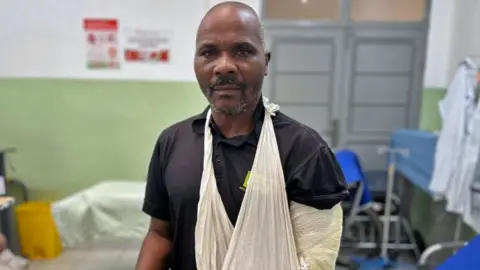 BBC
BBCWhen I first drove into the city of Goma in eastern Democratic Republic of Congo, it was hard to tell I had entered a conflict zone.
Goma residents filled the streets a few miles from the border with Rwanda - commuters headed to work, hawkers sold goods by the roadside and taxi drivers scrambled to win customers.
But it only took a few minutes to realise there was a new "government" in town.
As I reached a checkpoint near a police post formerly run by the Congolese authorities, gun-toting fighters from the M23 rebel group stopped my car.
The M23 captured Goma, a city of nearly two million people, last week after a lightning advance in DR Congo's eastern region.
At least 700 people in the city were killed and close to 3,000 injured as the rebels clashed with DR Congo's army and its allies, according to the UN and the Congolese government.
The M23, which is made up of ethnic Tutsis, say they are fighting for the rights of their minority group, while DR Congo's government says the Rwanda-backed rebels are seeking to exploit the eastern region's vast mineral wealth.
At the checkpoint, rebel fighters peered into my car, asked my driver a few brief questions, then waved us into the devastated city.
The rebels faced no opposition - it was like they had always been there.
I made my way to one of the few hospitals treating wounded victims and as I entered, cries of pain echoed through the corridors.
I met Nathaniel Cirho, a medical doctor who, in a strange role reversal, sat in a hospital bed with a sling around his left arm.
A bomb had landed on the house next to his and Mr Cirho and his neighbours were struck by the resulting shrapnel.
"I sustained an injury on my arm. A 65-year-old man was injured on his abdomen. After surgery, he didn't survive," he said sadly.
Several wards away, an elderly woman lay in her another hospital bed, hooked up to an oxygen tank.
She had plucked a bullet out of her own arm after a fierce exchange of fire broke out in her neighbourhood.
"Suddenly my hand felt cold, and I realised I had been shot," she said, struggling to talk.
For days, she had nursed the gunshot wound without help. She told me she was eventually escorted to a public hospital by M23 fighters.
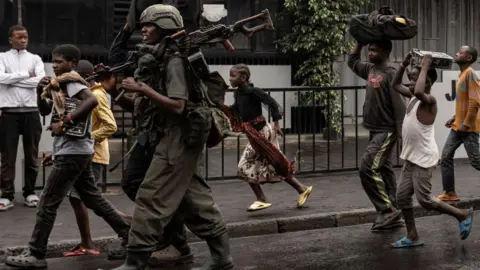 Getty Images
Getty ImagesThe woman asked to be moved to a private hospital, where she is now receiving treatment, because she was not getting adequate attention from the overstretched doctors.
But even at this second hospital, medics were overwhelmed as an increasing number of patients came through the doors.
"We have treated most of them because we had contingency plans," said a doctor, who did not want to be named for security reasons.
He added: "On Sunday when the fighting began, we received 315 patients and we treated them."
But now, the hospital counts over 700 patients with various degrees of injury, the doctor told me.
He spoke of receiving patients with "gunshot wounds to the head, others on the chest, stomach, hands and legs".
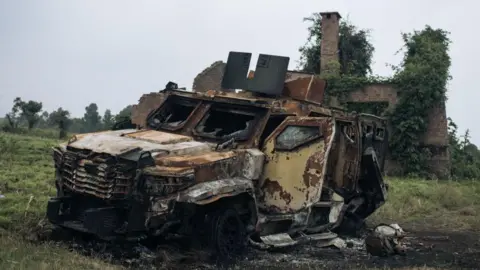 Getty Images
Getty ImagesAs DR Congo reels from the shock of seeing Goma captured, the UN's Office of the High Commissioner for Human Rights has warned that sexual violence is being used as a weapon of war by rival groups.
The doctor in this private hospital corroborated the UN's statement, saying his facility had so far received about 10 victims of rape and gender-based violence.
Outside the hospital and into the city centre, there was a mixture of serenity and circumspection.
People walked past four bullet-riddled vans, testimony to what had played out while they were sheltering for safety.
Although the gunfire and explosions in Goma have all but died down, not all establishments are back to business as normal. A few shops have opened in certain streets, but not in others. Major banks also remain shuttered.
- The evidence that shows Rwanda is backing rebels in DR Congo
- What's the fighting in DR Congo all about?
Perhaps some remain wary that anything could happen amid the volatile security situation in the wider North Kivu province.
"People are afraid… I am still afraid because those who caused the tension are still with us and we don't know what is going on," shop owner Sammy Matabishi said.
"But the bad thing is that there are no people to buy from us, many have gone to Rwanda, [the Congolese city of] Bukavu, Kenya and Uganda."
He adds that traders who import goods from neighbouring countries have been unable to transport products into city.
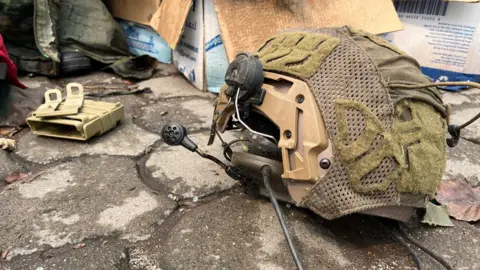
Many residents I spoke to said they had come to terms with the M23 running the place.
And as an outsider I could see the rebels were intent on asserting their control.
They had taken over the office of the North Kivu military governor, who they had killed as they advanced on Goma.
Fighters were also present in strategic areas around the city, while others patrolled the streets on pick-up trucks, weapons in hand.
During the whole time I was in Goma, I did not see a single active Congolese soldier.
I did, however, see abandoned trucks emblazoned with "FARDC", the French acronym for DR Congo's armed forces.
Near the base of the UN peacekeeping mission (Monusco) - who have been tasked with protecting civilians from rebel forces - military fatigues, magazines and bullets were strewn across the road.
"When M23 arrived here, they surrounded our army," Richard Ali, who lives nearby, told me.
"Many removed their military uniforms, threw away their weapons and wore civilian clothes. Others ran away."
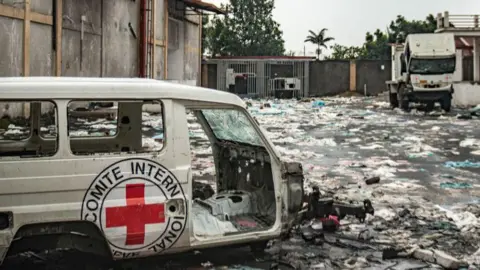 Getty Images
Getty ImagesAs the M23 rejoices over its conquest, the Congolese government continues to deny the rebels' claim that they have totally captured Goma.
The authorities accuses the M23 of illegally occupying their land - with the support of Rwanda - and promises to recover any lost territory.
Although Rwanda used to consistently deny backing the rebels, its response has shifted to a more defensive one, in which government spokespeople state that fighting near its border is a security threat.
The rebels are now reported to be moving south towards Bukavu, the capital of South Kivu, and have vowed to reach the capital, Kinshasa, even though it is 2,600km (1,600 miles) away.
For now, Goma remains their biggest coup. Conditions there foreshadow what life could become for many more Congolese people, should the M23 gain more ground.
Additional reporting from the BBC's Robert Kiptoo and Hassan Lali in Goma
More about the conflict in DR Congo:
 Getty Images/BBC
Getty Images/BBCGo to BBCAfrica.com for more news from the African continent.
Follow us on Twitter @BBCAfrica, on Facebook at BBC Africa or on Instagram at bbcafrica
